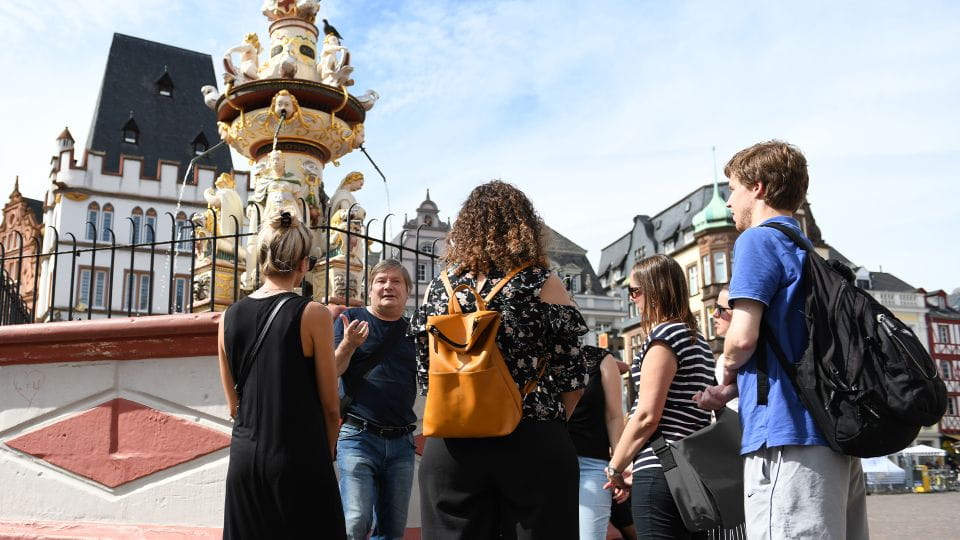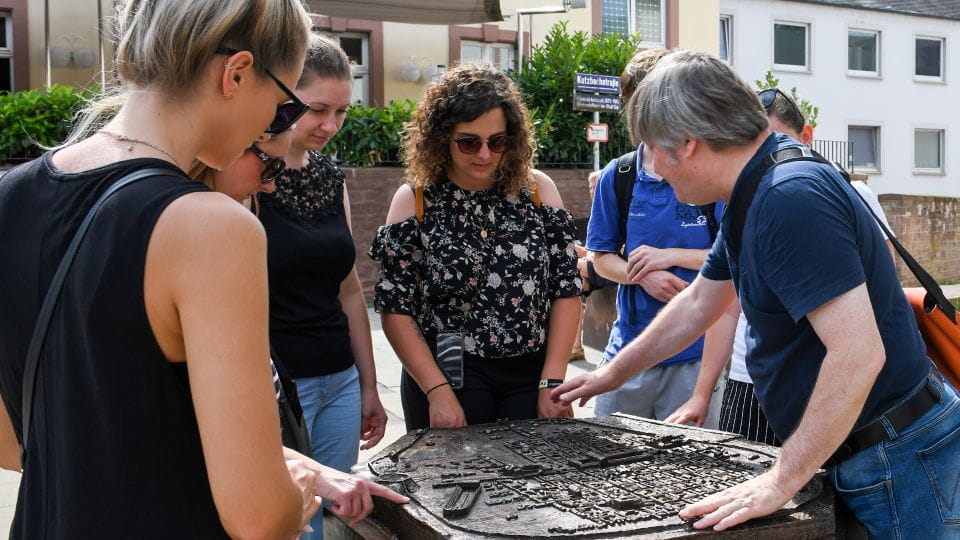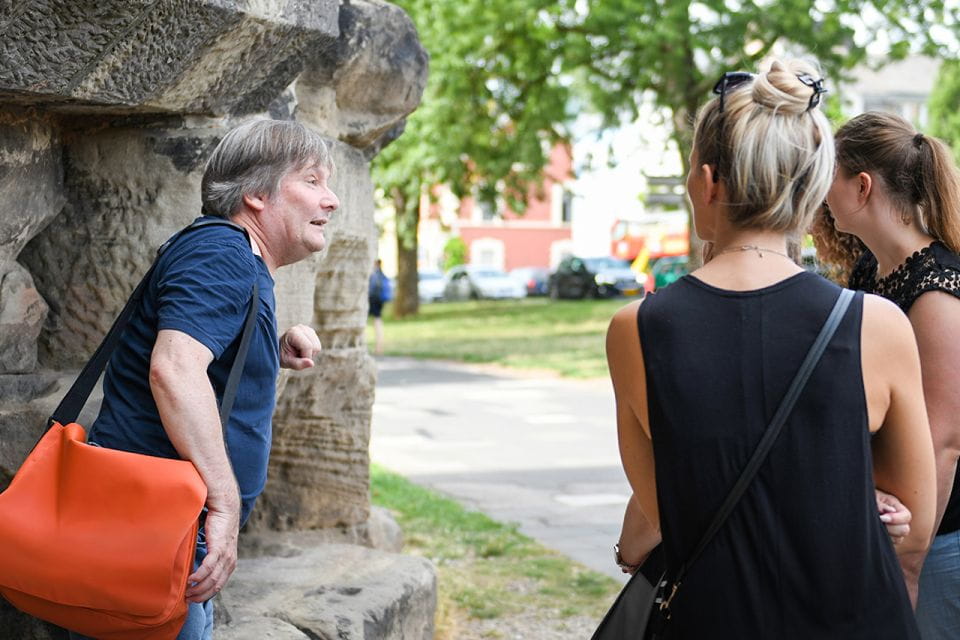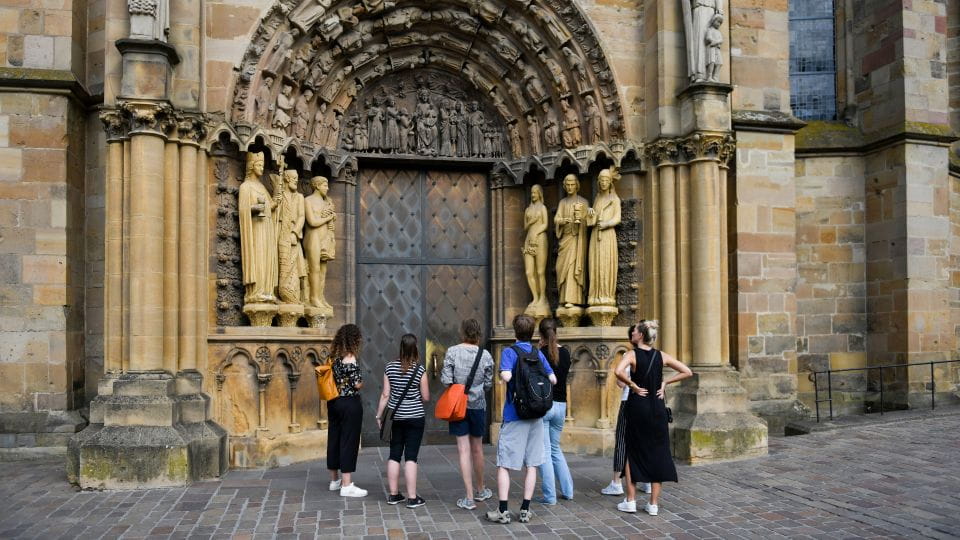Trier, Germany’s oldest city, beckons visitors to uncover its rich tapestry of history through a guided walking tour of the Old Town. From the awe-inspiring Porta Nigra, a Roman gate dating back to 170 AD, to the captivating Gothic spires of the Trier Cathedral, each step reveals the city’s evolution from a thriving Roman settlement to a vibrant modern hub. As the tour progresses, travelers will not only explore the city’s medieval architecture but also discover the lasting influence of iconic figures like Karl Marx. With each turn, the tour promises to peel back the layers of Trier’s past, leaving visitors eager to delve deeper into its enduring legacy.
Key Points

- Explore the well-preserved Roman heritage of Trier, including the iconic Porta Nigra, the largest Roman city gate north of the Alps.
- Discover the city’s medieval architectural gems, such as the Gothic Trier Cathedral and the charming half-timbered houses in the Main Market.
- Uncover the influential figures who have shaped Trier’s history, including the philosopher Karl Marx, whose childhood home is a popular attraction.
- Gain insights into the captivating evolution of Trier from a thriving Roman settlement to a vibrant modern urban center.
- Set out on a guided walking tour that offers a comprehensive understanding of Trier’s rich cultural and historical legacy.
Discover Trier’s Roman Heritage

During the walking tour, visitors can explore Trier’s well-preserved Roman heritage, including the iconic Porta Nigra gate, which dates back to 170 AD.
This colossal four-story structure is the largest Roman city gate north of the Alps and a testament to the city’s prosperous past. As they wander through the gate, guests will learn about daily life in Trier during the Roman era, when it was a thriving commercial hub.
The tour also covers other Roman ruins, giving guests a glimpse into the city’s origins and the enduring influence of the Roman Empire on Trier’s architecture and culture.
Loving the local insights? Here are more guided experiences we recommend in Trier
Exploring Trier’s Medieval Architecture

As visitors stroll through Trier’s Old Town, they’ll encounter a captivating blend of architectural styles that showcase the city’s rich medieval heritage. From the striking gothic spires of the Trier Cathedral to the quaint half-timbered houses lining the Main Market, the city’s medieval structures bear witness to its enduring cultural legacy.
| Medieval Structure | Architectural Highlights |
|---|---|
| Trier Cathedral | Gothic spires, ornate facades |
| Main Market | Charming half-timbered houses |
| Steipe Building | Renaissance-style facade |
| St. Gangolf Church | Late Romanesque architecture |
| City Wall | Defensive medieval fortifications |
The interplay of these diverse medieval elements creates a harmonious and visually captivating urban landscape, allowing visitors to enjoy Trier’s storied past.
Influential Figures in Trier’s History

Trier boasts a rich tapestry of influential figures who’ve left an indelible mark on the city’s history, from philosophers and scholars to religious leaders and political icons.
Perhaps the most renowned is Karl Marx, the father of communism, whose childhood home in Trier is a popular stop on the walking tour.
Visitors can also explore the Trier Cathedral, a stunning example of Romanesque architecture that has been a spiritual center for centuries.
Plus, the city has produced renowned theologians and philosophers, including the renowned medieval scholar Nicholas of Cues.
These influential figures have all contributed to Trier’s enduring legacy as a hub of intellectual and cultural significance.
Highlights of the Walking Tour

The guided walking tour offers visitors a chance to admire Trier’s key sights, from the awe-inspiring Porta Nigra, a Roman gate dating back to 170 AD, to the iconic Trier Cathedral, a stunning example of Romanesque architecture that has stood as a spiritual center for centuries.
The tour also takes guests to the Main Market, a lively hub where historic buildings and charming cafes create a vibrant atmosphere.
Another highlight is the residential house of influential philosopher Karl Marx, where guests can learn about this renowned thinker’s life and legacy.
Throughout the tour, the guide shares captivating anecdotes and insights, bringing Trier’s rich history to life.
Trier’s Evolution From Roman to Modern
Centuries of rich history have shaped Trier’s evolution from its Roman origins to the modern-day metropolis it’s today.
As one of Germany’s oldest cities, Trier was once a thriving Roman settlement, with imposing structures like the Porta Nigra gate still standing today.
Over the centuries, the city’s architecture shifted, reflecting the influence of the Middle Ages and beyond.
Visitors can witness this evolution, from the grand cathedral to the quaint market squares.
Throughout it all, Trier has maintained its status as a hub of culture and commerce, attracting travelers and locals alike.
This guided walking tour offers a chance to explore the city’s captivating past and see how it’s transformed into the vibrant urban center it’s now.
If you're enjoying exploring Trier on foot, you'll love these other walking tours we recommend
Insights Into Daily Life in Roman Trier
Stepping back in time, one can envision the bustling daily activities that unfolded within Trier’s Roman walls, where citizens navigated the intricate web of societal structures and cultural norms.
The Porta Nigra, a magnificent Roman gate, served as a gateway to the city’s vibrant marketplace, where merchants traded goods and artisans showcased their wares.
Roman Trier was a thriving hub of commerce, with residents engaging in a variety of occupations, from farmers and craftsmen to administrators and scholars.
The city’s affluent citizens enjoyed the luxuries of public baths, theaters, and grand villas, while the working class toiled to sustain the bustling urban economy.
Trier’s Roman heritage is palpable, offering glimpses into the daily rhythms of life centuries ago.
The Enduring Legacy of Karl Marx
Amidst the city’s Roman grandeur, the residential house of one of Trier’s most influential figures, philosopher Karl Marx, stands as a poignant reminder of the lasting impact he’s had on the world.
During the walking tour, visitors can explore the childhood home of the renowned socialist thinker, where he was born in 1818. Here, they’ll learn about Marx’s formative years and the development of his revolutionary ideas, which would go on to shape the course of history.
The guide will share insights into how Marx’s teachings continue to resonate, influencing modern political and economic thought. This stop on the tour offers a unique opportunity to connect with the intellectual legacy of one of Trier’s most famous sons.
Tour Details and Booking Information
Offered in German, the guided walking tour of Trier’s Old Town highlights and history lasts approximately 1.5 hours.
Free cancellation is available up to 24 hours in advance, allowing visitors to reserve now and pay later.
The live tour guide brings the city’s Roman origins and medieval architecture to life through engaging stories and anecdotes.
Visitors will admire key sights like the Porta Nigra, Trier Cathedral, and Main Market, as well as the residential house of influential philosopher Karl Marx.
With a focus on the city’s evolution, the tour provides a rundown of Trier’s enduring legacy as Germany’s oldest city.
Frequently Asked Questions
Is the Tour Accessible for Individuals With Mobility Issues?
The tour may not be fully accessible for individuals with mobility issues. Some sights and areas visited may have uneven terrain or steps, making it challenging for those with limited mobility. Visitors should inquire about accessibility accommodations.
Can the Tour Be Customized for Specific Interests or Requests?
Yes, the tour can likely be customized to accommodate specific interests or requests. The tour provider may offer personalized options or allow guests to highlight their areas of interest during the walk.
What Should Participants Bring or Wear for the Walking Tour?
Participants should wear comfortable walking shoes and dress for the weather. It’s also a good idea to bring water, sunscreen, and any necessary medications. The tour involves extensive walking, so preparing appropriately will ensure an enjoyable experience.
Are There Any Discounts or Special Rates Available for the Tour?
There are often discounts or special rates available for walking tours, such as reduced prices for students, seniors, or groups. Visitors should check the tour provider’s website or inquire when booking to see if any special offers apply.
Can the Tour Be Conducted in Languages Other Than German?
Yes, the tour can be conducted in other languages besides German. The tour company offers live tour guides who can lead the walking tour in various languages to accommodate international visitors.
Recap
The guided walking tour of Trier’s Old Town offers an immersive glimpse into the city’s rich history.
Visitors can explore its well-preserved Roman ruins, admire its medieval architecture, and learn about influential figures like Karl Marx.
From a thriving Roman settlement to a modern urban center, Trier’s evolution is a testament to its enduring legacy as a cultural and historical gem in Germany.
More Tours in Trier
More Tour Reviews in Trier
Not for you? Here's more things to do in Trier we have recnetly reviewed
- Trier: early morning tour without the hustle and bustle and with less noise
- Trier City Walking Tour
- Trier, Moselle: Wine excursion with boat trip
- Trier: Roman thermal baths
- Trier: Beginner SUP Course
- Trier: Solve the Mystery of the Merchant’s Gold!
- Trier: Discovery tour – Germany’s oldest wine cellar
- Trier: SUP Yoga Course
- Trier: Express City Walking Tour with Local Guide
- Trier compact: Anecdotal and funny city tour
- Adventure tour: The Devil in Trier
- Trier: Your Adventure Awaits – The Return of the Elector
